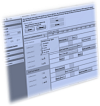|

Resources
Application
Building Blocks
DBiWSF
Objects
Developer
Resources
Developer
documentation
|
|
DBI Warehouse Shipments Scheduling
Framework -
Glossary of Terms
Meeting developer requirements
for supply chain - warehouse shipments scheduling
Breakout
Docks - If a shipment requires more
than one dock to unload an inbound shipment or package an outbound shipment then
the shipment can be flagged with breakout docks.
Business Rules - A class built to allow for the processing of
enterprise wide business rules against the various dbiWSF objects regardless of
the UI being used.
CMAP - Not to be confused with the MFC commands, the CMAP in
the dbiWSF Source refers to column mapping wherein the developer can create
direct mappings between database column names and object properties. By default
if the property shares the same name as the column, the reflection used in the
dbiWSF will automatically map the two without developer intervention.
Cross-Docking - An occurrence where the contents of one
container are directly transferred to another container without impacting the
stock levels in the warehouse.
Customer - The end
user of goods for outbound shipments. This is used primarily as a point of
integration into existing Order Entry/Invoicing systems.
dbiWSF - The DBI Warehouse Shipments Framework product.
Exceptions - Not to be confused with .NET exceptions, the WSF
exceptions are objects which can be used to temporarily block access to a
loading dock (such as maintenance or lunch times).
GUIDs - Globally Unique Identifiers
- The dbiWSF is designed
from the ground up as a single user application, however the databases are
structured such that it can be used in multi-user environments without the worry
of duplicate keys and the ability to easily manage concurrency issues. The GUID
based keys allow for quick access to the objects in memory using LINQ as there
is then no worry of crossing over index values. This is integral to the data
binding used in the dbiWSF.
Loading Dock - A loading dock is the second layer of the dbiWSF
resource tree. This object is where the shipments reside. A loading dock can be
anything the developer needs it to be, from a fixed loading dock to a mobile
crane in a shipyard. The dbiWSF has the ability to transfer loading docks
between warehouses while keeping the data synchronized.
Point(s) of Integration - Throughout the sample application,
movies and source code, we reference Point(s) of Integration. This refers to
properties, events and methods that can be used to tie the dbiWSF to other
applications or databases. This can be handled in several ways from base
integration at the databinding layer all the way through to the UI events for
more contextual updates or loads.
Recurrences - A class built to allow for recurring exceptions
or other objects (such as recurring shipments).
Shipment
- A
shipment is the base unit of transfer, it represents a collection of OrderHeader
objects. This can be made up of one to many cargo manifests (order headers)
which then can have zero to many order details which make up the items on that
shipment. A shipment is designed to be flexible in that it can represent a
trailer load, cargo container, train car, airplane, overseas carrier, etc.
Vendor - A supplier of goods for inbound shipments. This is
used primarily as a point of integration.
Warehouse - The parent item in the dbiWSF resource tree. There
can be one to many warehouses so there is great flexibility in how the software
is setup. Each warehouse will have one to many loading docks (see Loading Dock).
|
|





|